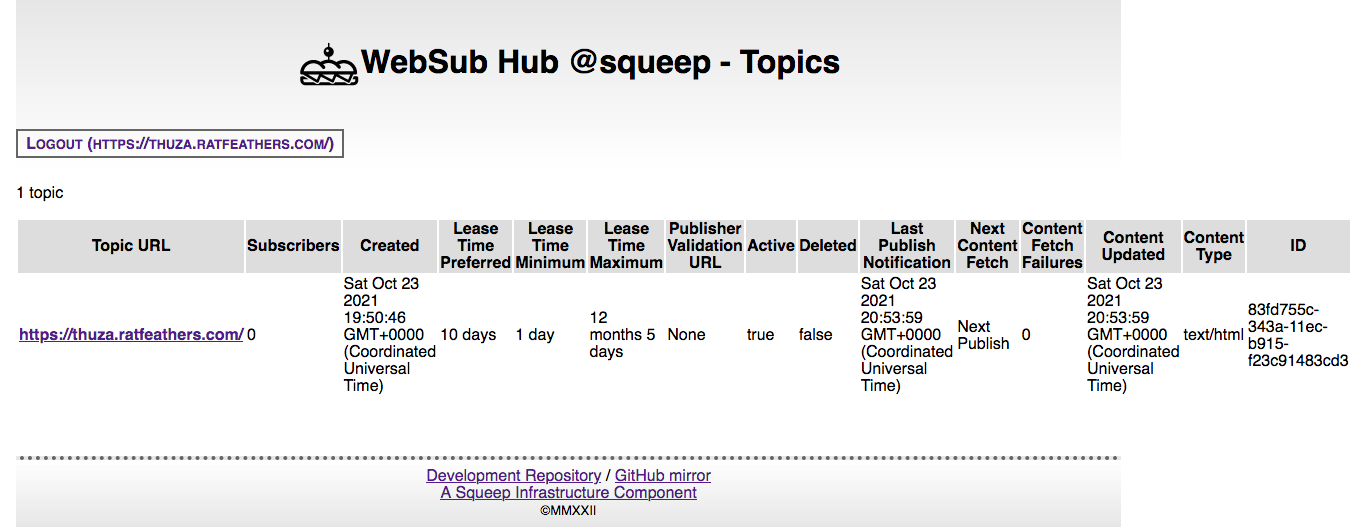WebSub is a protocol for subscribing to content updates from publishers. The Hub is the central component which manages that relationship.
This Hub implementation was created with personal self-hostable deployment in mind. It is content-agnostic, supports multiple database backends, and can scale to multiple nodes for robustness and capacity.
This is currently a Minimum Viable Product release. Basic functionality is complete, but the administration experience may be challenging.
Customize configuration within config/${NODE_ENV}.js. All envs inherit settings from default.js if not specified. Environment is selected using the NODE_ENV value, defaulting to development if unset.
Database table initialization and schema version migrations are automated. Configure SQLite with a database file, or point PostgreSQL to a created database.
A user will need to be created in order to view the /admin pages; the bin/authAddUser.js script will do this.
The bundled logger spews JSON to stdout.
An IndieAuth profile may be used to view any topics associated with that profile.

One way of deploying this server is behind nginx, with the pm2 package to manage the server process, and a local postgres database. Some details on this are presented here as a rough guide to any parts of this stack which may be unfamiliar.
- Have NodeJS 14-ish available.
- Have PostgreSQL available.
- Clone the server repository.
git clone https://git.squeep.com/websub-hub - Install the production dependencies.
cd websub-hub
NODE_ENV=production npm i - Create a
config/production.jsconfiguration file. Seeconfig/default.jsfor available settings.'use strict'; // Minimum required configuration settings module.exports = { encryptionSecret: 'this is a secret passphrase, it is pretty important to be unguessable', dingus: { selfBaseUrl: 'https://hub.squeep.com/', }, db: { connectionString: 'postgresql://websubhub:mypassword@localhost/websubhub', }, }; - Prepare PostgreSQL with a user and database, using e.g.
psql.CREATE ROLE websubhub WITH CREATEDB LOGIN PASSWORD 'mypassword'; GRANT websubhub TO postgres; CREATE DATABASE websubhub OWNER=websubhub; GRANT ALL PRIVILEGES ON DATABASE websubhub TO websubhub; \c websubhub CREATE EXTENSION IF NOT EXISTS pg_stat_statements;
- Install the process manager, system-wide.
npm i -g pm2 - Configure the process manager to keep the server logs from growing unbounded.
pm2 install pm2-logrotate
pm2 set pm2-logrotate:rotateInterval '0 0 1 * *'(rotate monthly)
pm2 set pm2-logrotate:compress true
pm2 startup(arrange to start process monitor on system boot) - Launch the server, running one process per CPU, and persist it through reboots.
NODE_ENV=production pm2 start server.js --name websubhub -i max
pm2 save - Create an administration user.
NODE_ENV=production node bin/authUserAdd.js admin - Copy the static files to somewhere nginx will serve them from. This will vary greatly depending on your setup.
cp -rp static /home/websubhub/hub.squeep.com/html/static - Expose the server through nginx.
server { listen 443 ssl http2; ssl_certificate /etc/ssl/nginx/server-chain.pem; ssl_certificate_key /etc/ssl/nginx/server.key; server_name hub.squeep.com; root /home/websubhub/hub.squeep.com/html try_files $uri $uri/ @websubhub; location @websubhub { proxy_pass http://websubhub$uri; proxy_set_header Host $host; proxy_set_header X-Forwarded-For $remote_addr; proxy_set_header X-Forwarded-Proto $scheme; proxy_http_version 1.1; } location = / { proxy_pass http://websubhub$is_args$args; proxy_set_header Host $host; proxy_set_header X-Forwarded-For $remote_addr; proxy_set_header X-Forwarded-Proto $scheme; proxy_http_version 1.1; } }nginx -s reload - The Hub server should now be available!
A rudimentary tally of a topic's subscribers is available on the /info?topic=topicUrl endpoint. The topicUrl should be URI encoded. Formats available are SVG badge, JSON, and plain text, selectable by setting e.g. format=svg in the query parameters.
The Hub keeps track of three primary entities:
- Topics: data and metadata for a published content endpoint. Topics are unique by source URL.
- Subscriptions: the relationship between a client requesting content and the topic providing it. Subscriptions are unique by topic and client URL.
- Verifications: updates to subscriptions which are pending confirmation. Verifications are not unique, but only the most recent for any Subscription pairing will be acted upon.
Any tasks in progress (notably: fetching new topic content, distributing that content to subscribers, or confirming pending verifications) are doled out and managed by a cooperative advisory locking mechanism. The task queue is wrangled in the database within the *_in_progress tables.
A Hub node will periodically check for more tasks to perform, executing them up to a set concurrency limit.
This implementation is built atop an in-house API framework, for Reasons. It would not be hard to replace such with something more mainstream, but that is not currently a design goal.
- bin/ - utility scripts
- config/
- default.js - defines all configuration parameters' default values
- index.js - merges an environment's values over defaults
- *.js - environment specific values, edit these as needed
- server.js - launches the application server
- src/
- common.js - utility functions
- communication.js - outgoing requests and associated logic
- db/
- base.js - abstract database class that any engine will implement
- errors.js - database Error types
- index.js - database factory
- schema-version-helper.js - schema migrations aide
- postgres/
- index.js - PostgreSQL implementation
- listener.js - notify/listen connection to support topic content caching
- sql/ - statements and schemas
- sqlite/
- index.js - SQLite implementation
- sql/ - statements and schemas
- enum.js - invariants
- errors.js - local Error types
- link-helper.js - processes Link headers
- logger/ - adds service-specific data filters to our logging module
- manager.js - process incoming requests
- service.js - defines incoming endpoints, linking the API server framework to the manager methods
- template/ - HTML content
- worker.js - maintains a pool of tasks in progress, for sending out updates, performing verifications, et cetera
- static/ - static assets
- test/ - unit and coverage tests
- test-e2e/ - support for whole-service testing
